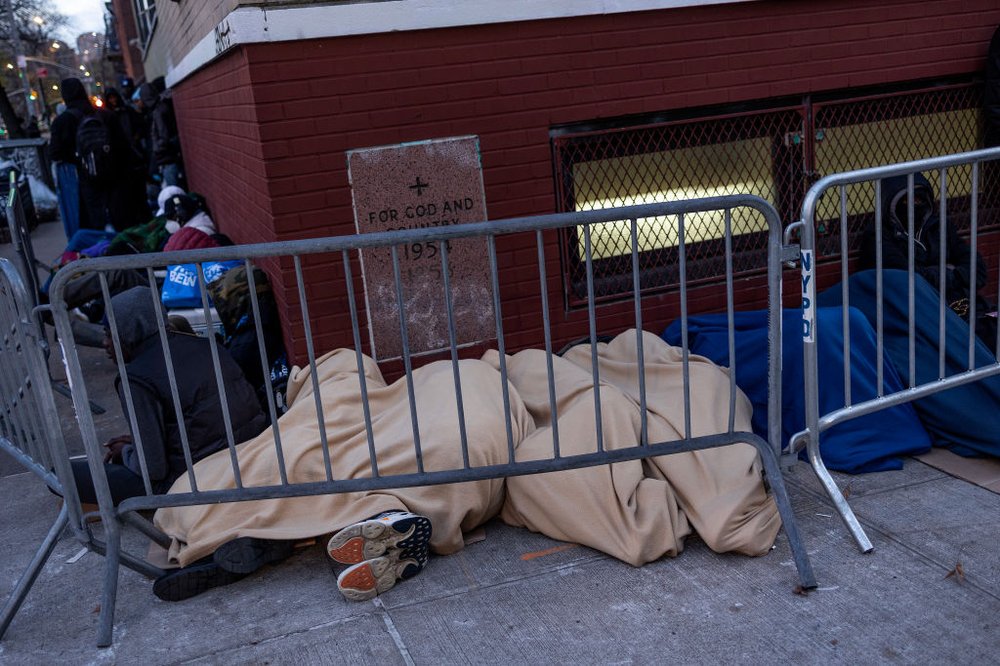How will NYC implement settlement on migrants? Big questions remain.
March 19, 2024, 6:01 a.m.
The agreement calls for clearing a waitlist for migrants seeking shelter. Where will they go?

Major questions remain as to how New York City will implement key terms of a new court settlement allowing the Adams administration to limit shelter stays for most migrant adults, as it has been doing for months but without legal cover.
Significantly, the settlement requires the city by April 8 to eliminate a waitlist for migrants seeking shelter beds, after Mayor Eric Adams has repeatedly said the city’s out of shelter space.
And while the agreement says the city will grant extensions to migrants facing extenuating circumstances, what qualifies as such is hardly clear.
Moreover, while the city has trumpeted its efforts to connect migrants with caseworkers to help them exit the shelter system, housing and migrant advocates have repeatedly criticized those efforts as insufficient, and hampered by language barriers and the sheer number of migrants needing help.
Nonetheless, the city is on the hook for executing the settlement. It ends months of negotiations between Legal Aid attorneys and the administration, which has sought flexibility to modify the city’s unique right-to-shelter rules, in the face of an emergency. The city has struggled to accommodate an influx that has seen over 180,000 migrants come to New York City since April 2022.
“We’re going to be monitoring it very carefully,” said Josh Goldfein, staff attorney for Legal Aid, one of the court-appointed monitors in the lawsuit. He added: “We’re going to be intervening” in cases of concern.
Here’s what to watch in the aftermath of the long-awaited settlement.
How will the city eliminate its shelter waiting list for migrants?
About 1,900 single adult migrants are currently on the city’s shelter waitlist — that is, they were forced to leave city shelters under the city’s current 30- and 60-day stay limits, and have reapplied for another place to stay, according to City Hall spokesperson Kayla Mamelak.
The number on the waitlist varies from day to day, at times fluctuating as high as some 3,000 people.
While migrants wait for another shelter bed, the city has allowed them to stay in ad-hoc shelter sites, often called “waiting rooms” by City Hall officials. They generally offer no beds or cots.
The settlement requires the city to stop housing eligible migrants in those “waiting rooms,” and offer them facilities with beds instead. The “waiting rooms” will still be available to other migrants who refuse other city accommodations or arrive late at night.
“There won’t be anyone on the waiting list,” Goldfein said. “They’ve agreed to end that by April 8th.”
But where will those on the waitlist end up? Mamelak said the city is working to find more shelter space, and she notes some on the list likely have already found housing on their own.
She pointed to the decrease in the number of migrants staying in city shelters in recent months as an indication that the city may have more room to help. The shelter population stood at nearly 70,000 earlier this year; it has since dropped to about 65,000, as more migrants have been forced out.
And Mamelak said there were other short-term options for the city to expand its shelter space by the April 8 deadline. For example, the city may be able to add extra beds to some of the existing 218 shelter sites.
What constitutes extenuating circumstances?
While the settlement clearly gives the city more authority to move migrants out of the shelter system, it also provides a lifeline of sorts to migrants facing extenuating circumstance or who have made significant efforts to find housing outside the shelter system and yet remain.
The agreement, though, doesn’t fully spell out what either of those terms means, except to say extensions will be determined on a “case-by-case basis.”
The 24-page settlement provides some examples of what could be grounds for granting an extension — such as having a serious medical procedure in the coming month. And the city has noted that migrants with disabilities would qualify as well, as was the case before the settlement.
The agreement provides examples of what qualifies as “significant efforts” to leave the shelter system, such as making an appointment with an immigration lawyer, getting a driver’s license, enrolling in job training programs and searching for a job.
But, once again, the term isn't fully defined. That's left up to the city's discretion.
What about help accessing services?
Migrants leaving the system must receive a written document explaining the city's reticketing services. The document explains how migrants can access city-funded travel tickets to go elsewhere, at no cost to migrants, other city resources available, and how they can contact a city staffer to potentially extend their stay.
The settlement requires all communications with migrants in this process to be in “their preferred language.” Mamelak said migrants seeking to extend their stays will be able to request to do so through shelter caseworkers.
"The plan is intensified casework," Mamelak said.
But immigrant and housing advocates have long criticized the city for what they’ve called inadequate language services for migrants, insufficient casework services to help migrants move out of city shelters, and a lack of clarity among migrants about the city’s shelter rules.
The settlement offers little guidance on how those longstanding challenges will be overcome.
The agreement has some housing and immigration advocates renewing their warnings that the city's shelter limits will lead to more street homelessness.
NYC Mayor Adams reaches settlement in fight to roll back right to shelter New Yorkers back ‘right to shelter,’ but hold ambivalent views on housing migrants How Mayor Adams was able to bypass NYC’s decades-old right-to-shelter rules